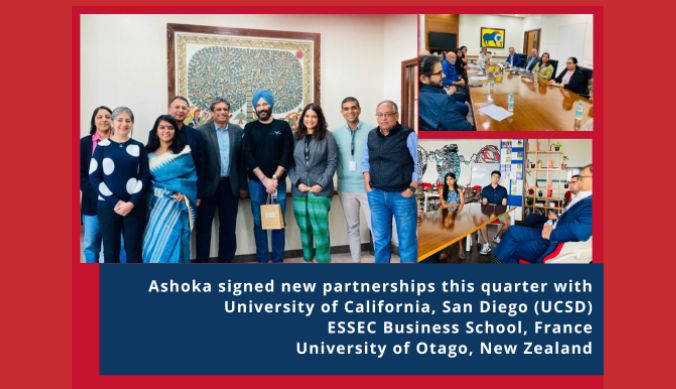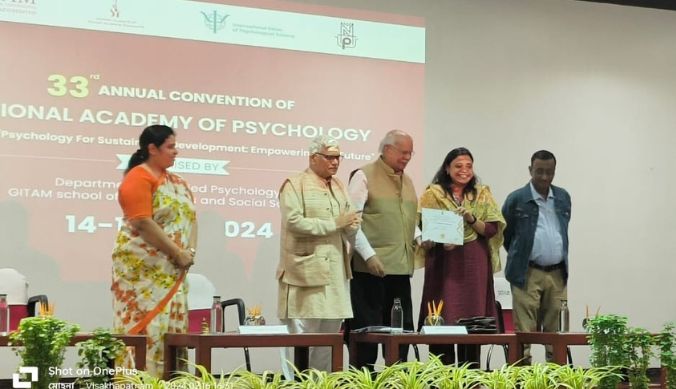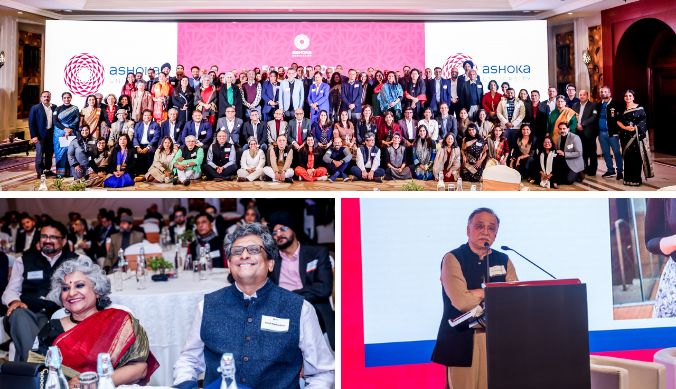Changing face of Philanthropy in India
The Centre for Social Impact and Philanthropy conducted a research-related roundtable on the 9th of February, 2017 at the India Innovation Centre with eminent leaders of NGOs, research organizations and philanthropists.

Office of PR & Communications
10 February, 2017 | 8 min readBy Anita Rajan
The idea of philanthropy has gone beyond the mere act of signing cheques by big multinationals and High Net-worth Individuals (HNIs) for worthy causes such as poverty alleviation, disaster relief and literacy. In 2013, The Companies Act included a clause which states, “In accordance with the 2013 Act, the board of each company covered under the CSR requirement needs to ensure that the company spends, in every financial year, at least 2% of its average net profits made during the three immediately preceding financial years in pursuance of CSR policy”.
Since then, there has been an evident increase in terms of philanthropic investment by corporates. The question being asked in the status quo by various stakeholders revolves around the “true meaning of philanthropy” vis-à-vis what it used to mean before the bill was passed, where only a handful of organizations signed on to help create impact in civil society and also held themselves responsible for the extent of the impact.
With the recent addition to the Companies Act in correlation with minimum CSR distributions, not-for-profits organizations and policy makers have questioned the extent to which corporations should be accountable for the donations they make towards various social causes.
In a study by Alliance Magazine and Dasra on the “Power of Philanthropy in India”, it was seen that private giving increased by 50 percent, between 2006 to 2011. After this period, there was an estimate, which predicted steady increase in the rate of giving. Whilst figures and statistics still show a rise in the giving quotient, the progress in philanthropy has not been “all-embracing” and “headlong”, according to Alison Bukhari, Former Director of Investor Relations at Dasra UK.
To truly understand what Philanthropy really means in an Indian context, one must start at the root of figuring out the demographic of the country’s big-givers. It is said that there are two generations of givers —- one, encompassing business leaders and entrepreneurs who have been building their own businesses post-liberalisation. Secondly, the children of wealthy entrepreneurs and HNIs, most of who have returned to the country after education in the West and have observed and been influenced by the philanthropic practices there.
As Alison writes in her opinion piece in Alliance Magazine, the two generations of philanthropists working in tandum, can bring about a paradigm shift in the way that philanthropy can operate in the country; with the first-generation increasing the volume of giving whilst the second-generation are refining the approach towards giving.
Ingrid Srinath, Director at Ashoka University’s Centre for Social Impact and Philanthropy has written an article on the changing face of Indian philanthropy, where she notes the difference in the approach to philanthropy between these two generations: Traditional philanthropy emphasized on nation-building and addition to the country’s academic, scientific and cultural institutions post independence and post-liberalisation. In addition to this, Ingrid writes that “ Alleviating the condition of India’s poverty-stricken millions through delivering services – basic education, health, care for the elderly, the indigent and the infirm was another key philanthropic priority. Substantial sums were also dedicated to faith-based work and to the welfare of particular communities.”
In the newer models of Indian philanthropy, as Ingrid notes, there is focus and emphasis on skill-building and education, often with a “technocratic bent, informed as much by the philanthropist’s personal worldview as by the needs of those they might seek to serve.”
To address disparities between the two forms of Philanthropy, The Centre for Social Impact and Philanthropy conducted a research-related roundtable on the 9th of February, 2017 at the India Innovation Centre, where eminent leaders of NGOs, research organizations and philanthropists like Ashish Dhawan, Founder, Central Square Foundation sat down to discuss the gaps in knowledge and data in philanthropy and the role research can play in addressing these. The participants included stakeholders from organizations in the likes of Seva Mandir, Bill and Melinda Gates Foundation, Bridgespan and National Foundation for India.
Centre for Social Impact and Philanthropy’s Roundtable included two sessions to discuss the state of research in the philanthropic space.
Pramath Raj Sinha, Founder and Trustee, Ashoka University facilitated the discussion, dividing the session into two parts, one addressing the significant gaps that research in philanthropy in India has seen and how they are being addressed. The second half of the session involved brainstorming the kind of steps that should be taken towards filling these gaps, and the way in which this can be efficiently done.
One of the major gaps that were identified and agreed upon, was the absence of a networking space for philanthropic organizations alike, to sit down and understand the atmosphere prevailing in the sector at any given point of time.
Ashish Dhawan identifies two places where the Philanthropy sector needs to address the gaps that exist. He says, “There is no council on foundations, like in the United States, that exists here. There is an awareness platform, but there isn’t a learning or sharing platform. Also, there is no single platform for governance and policy that exists right now“.
With the release of the book ‘Charity Sucks’ by Iqbal Wahhab, the question of “Sustainable Philanthropy” has emerged more prominently, both within the sector and in the media. The idea of innovating accessible products and skill-building is looked at as a more endurable way of transforming the idea of giving, with corporations creating a long-lasting impact on civil society.
When asked Ashish whether this approach of donating via skill-building and close-monitored impact was indeed the right way to go forward, he said “ I’m not a proponent of shared value, it is often a way to put labels on the things you already do and I’m not sure that this is what we want to achieve. I think what we want right is more transparency, better organizations. What companies are able to do well is valuate programmes well, their competence and their ability to hold other organizations accountable. In this case, HNIs are more liberal, not insisting on all these things. I think it’s good not to be prescriptive. I think, let companies do what they want”.
Bain and Co.’s 2015 report on Philanthropy in India lists, “the philanthropy space in India is sorely lacking in trust. One of the top findings from our survey and interviews was that donors seek trust, so they gravitate towards relationships rather than causes. Some basic requirements of greater transparency are practices such as tracking, reporting and communicating results and details of fund utilisation.”
The conclusion? Philanthropy, or the idea of Daan has existed for centuries in our country, in various forms. A country with an expanding economy such as this, Arpan Sheth, who wrote Bain’s report, notes that we are indeed realising that these major holes in the blanket need to be addressed, for a smooth way forward.
He writes, “ As we see it, the future of philanthropy in India is a dynamic space where a deeper cause-oriented donor pool, with a larger number of activist donors, is energised by communicative and collaborative nonprofit organisations that deliver the greatest impact. The space is beginning to blossom—now all it needs is to be carefully tended.”













